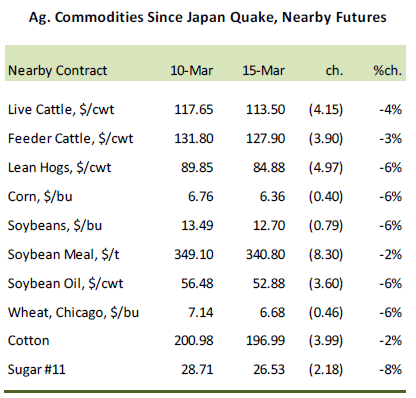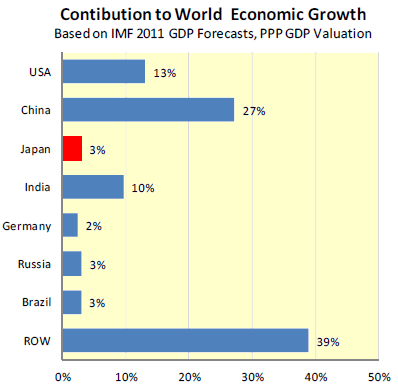



CME: Overall Impact of Japanese Nuclear Situation
GLOBAL - Futures prices for all agricultural commodities were sharply lower on Tuesday as the nuclear situation in Japan appeared to be spiraling out of control, write Steve Meyer and Len Steiner.A number of livestock and grain contracts declined the daily permissible limit as market participants sought to get out of long positions. Since 10 March, the day before Japan was hit by a 9.0 earthquake and the resulting tsunami, nearby live cattle futures have lost 415 points, feeder cattle have declined 390 points while lean hogs have shed almost 500 points (see table below).

That is in just three trading sessions. Small specs were noted to have significant
net long positions and these kinds of declines are bound to force some
people out. In all, a very negative and panicky day in the market yesterday.
Overnight futures appeared to rebound, however, as overseas markets stabilized
and buyers were out looking for bargains.
As we noted in our report yesterday, markets hate uncertainty and the
nuclear situation in Japan has made the outlook for the region as uncertain as
ever. Painful as it is, at least one can begin to tally the impact of the earthquake
or tsunami on the local population and infrastructure. At this time there
is no way to know how the nuclear situation will unfold. A New York Times
headline noted “Radiation’s Spread Hangs on Wind and Rain”. Talk about uncertainty.
Tokyo, a city of 13 million people, is only 150 miles south of the troubled
nuclear plant and the fear is that if fires in the plant get out of control,
they could easily contaminate a large part of the country. That would bring life
for millions of people to a standstill and inflict incalculable economic costs. For
now, however, that is all speculation but clearly it was driving equity and commodity
markets yesterday.
Some economists have noted that the overall impact of the Japan situation
on the global economy will be limited (assuming no large scale nuclear disaster)
since much of the growth in world economic activity currently is coming
from other markets. We went and pulled some forecasts for economic growth in
2011 and then calculated what percentage of world growth is attributable to
individual countries. There are different ways of doing such calculations but we
used the IMF 2011 forecasts of world GDP growth based on purchasing power
parity for individual countries. The results of our calculations are summarized
in the chart below, showing US growth is expected to contribute 13 per cent to overall
world growth in 2011 while China is expected to contribute about 27 per cent. Japan,
on the other hand, was forecast to add just 3 per cent to world growth in 2011. So
even if Japan swung into contraction this year, global growth would likely remain
intact. For now, however, markets want to see some end in sight for the
nuclear threat and, for the sake of the Japanese people, we pray it comes soon.









